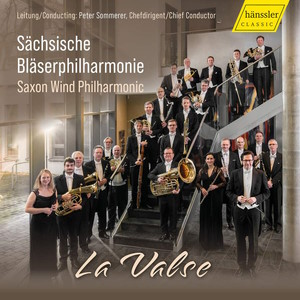
La Valse
Hector Berlioz (1803-1869)
Le carnaval romain Overture, Op. 9 (arr. wind orch, Tohru Takahashi)
Frédéric Chopin (1810-1849)
Les Sylphides [5:52] (arr. wind orch, Thomas Scheibe)
Maurice Ravel (1875-1937)
La Valse [14:01] (arr. wind orch, Siegmund Goldhammer)
Gabriel Fauré (1845-1924)
Pavane, Op. 50 [7:16] (arr. wind orch, Thomas Scheibe)
César Franck (1822-1890)
Le Chasseur maudit [15:46] (arr. wind orch, Stephan Hodel)
Sächsische Bläserphilharmonie/Peter Sommerer
rec. 2022, Deutsche Bläserakademie, Bad Lausick, nr. Leipzig, Germany
Hänssler Classic HC22068 [53]
This new Hänssler Classic album, La Valse, presents a programme of well-known symphonic works by Berlioz, Chopin, Ravel, Fauré and Franck arranged for wind, two by Thomas Scheibe and one each by Tohru Takahashi, Siegmund Goldhammer and Stephan Hodel.
Berlioz wrote a number of overtures, some for operas and others as standalone concert pieces. One such concert overture is Le carnaval romain written in 1843 and premiered in Paris, which uses themes from the opera Benvenuto Cellini but is entirely different from the opera’s actual overture. The Bläserphilharmonie, in spirited mood, savour this sparkling showpiece for winds arranged by Tohru Takahashi, creating a compelling carnival atmosphere; especially striking are the majestic opening and the big tune at 4:47, which is repeated three times.
Of French-Polish parentage, though Polish-born, Chopin settled in Paris from the age of twenty-one until his death aged thirty-nine, so it is not uncommon for him to appear on lists of French composers. Glazunov orchestrated several of his piano pieces, making a suite called Chopiniana. Michel Fokine choreographed it as Reverie Romantique: Ballet sur la musique de Chopin, which was short and essentially plotless, relying solely on dance and mood. It was performed at the Mariinsky Theatre, St. Petersburg in 1908. Ballet impresario Sergei Diaghilev had the Chopin piano pieces re-orchestrated by other composers into a version named Les Sylphides, premiered in 1909 in Paris by impresario Sergei Diaghilev’sBallets Russes. Taking just under six minutes here, it is the shortest work on the album. There is no sense of feeling short-changed by Thomas Scheibe’s arrangement, as the highly Romantic scoresounds magnificent in the hands of the thirty-four-strong wind orchestra.
Ravel’s La Valse, the album’s title track, is an undoubted masterpiece of the standard orchestral repertoire. Written in 1919/20, Ravel described it as ‘a choreographic poem…a sort of apotheosis of the Viennese waltz… the mad whirl of some fantastic and fateful carousel.’ Devised as a ballet score for the Ballets Russes but Diaghilev declined it as lacking theatricality. It was first performed in its orchestral version at Paris in 1920, which is how it is best known today. This first-class wind arrangement by Siegmund Goldhammer loses very little of the wide dynamics and importantly, the underlying tension is maintained.
One of Fauré’s finest works, the Pavane, Op. 50, was written in 1886 for an orchestral concert series and the next year an optional chorus was added using verses by Verlaine. A pavane is a slow and stately traditional court dance from the sixteenth century. Premieredin 1888 in Paris, it is one of Fauré’s most admired and performed scores, and can be heard in a number of arrangements. This splendid wind arrangement prepared by Thomas Scheibe maintains the elegant and rather hypnotic character of the score.
César Franck, like Chopin, was not a Frenchman by birth but Belgian-born and of part-German heritage. He spent the majority of his life in Paris and is often described as Franco-Belgian – and sometimes even as French. The longest work on the album, his Le Chasseur maudit (The Accursed Huntsman) is a symphonic poem premiered in Paris in 1883. Based on the lengthy verse Der wilde Jäger (The Wild Hunter) by German poet Gottfried August Bürger, it relates the tale of a Count of the Rhine who goes hunting in defiance of the Sabbath. Played without a break, the score is divided into four descriptive sections: The Peaceful Sunday Landscape, The Hunt, The Curse and The Demons’ Chase. Stephan Hodel’s striking wind arrangement sounds terrific. Standing out is the opening hunting horn theme evoking the readiness for the chase and also the rush of excitement as the demons pursue the terrified huntsmen.
Chief conductor and artistic director of the Sächsische Bläserphilharmonie is Peter Sommerer, who also serves as artistic director of the Deutsche Bläserakademie (German Wind Academy). He presides proudly over this orchestra of outstanding brass and woodwind players in these polished and praiseworthy performances. Their elevated level of ensemble and is especially noteworthy.
Recording in the Deutsche Bläserakademie, sound engineers Ines and Johannes Kammann of Nordklang Musikproduktion have achieved satisfying sonics. Musicologist Michael Kube provides the booklet notes which might have provided rather more detail on each work.
Michael Cookson
Help us financially by purchasing from





















